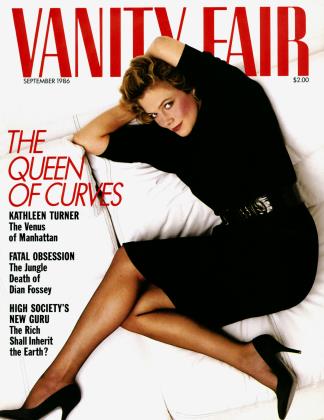Sign In to Your Account
Subscribers have complete access to the archive.
Sign In Not a Subscriber?Join NowArt Feud
Shoot-out in the East Village
You've probably never heard of Steven Klein or Mark Kostabi. Many people think you never should. Steven Klein is a thirty-five-year-old Brooklyn-born wheeler-dealer whose dabblings in artist management and publicity are the kind of thing the art world loves to pretend not to notice. He is best known as the man who shaped choreographer Molissa Fenley's internationally successful career—for almost six years, until their divorce, he was her manager and husband— and his aggressive salesmanship and marketing have forever changed the way the avant-garde is sold in this country.
Mark Kostabi is a twenty-five-year-old painter who came to the East Village art scene three years ago from Whittier, California—"the birthplace of Richard Nixon," he announces inaccurately. Although few admit to liking Kostabi's stylishly cynical paintings of armsattached-to-factories churning out paintings of drones-chuming-out-paintings, Kostabi does quite well. His work has been bought by MoMA and exhibited in nearly two hundred group and twenty one-man shows (until recently, without a dealer), and he has crisscrossed the globe seeking recognition as the very epitome of the East Village artist. Last year he netted over $100,000. ''Too many people have mistaken me as a careerist, even elevated me to the throne of yuppie prophet, spokesman of money-hungry opportunists," he complains. "In actuality, I've created a fictitious persona to expose how pathetic and vulgar people can become."
A year ago, Kostabi and Klein were introduced by a mutual friend. Kostabi wanted to exploit his art through jewelry, T-shirts, even furniture; Klein was hunting for clients. It seemed like a match made in heaven: the first artist with his own publicist.
Klein set up soirees where Kostabi could "meet the tastemakers." He took Kostabi to Europe for shows in Rome and Madrid. But mostly he played Henry Higgins to Kostabi's Eliza Doolittle. "There were graces and formats of social presentation he had no understanding of. He would ask me countless questions about living, eating, how you think, act, and behave in society."
Kostabi found himself deluged with offers, which Klein negotiated. The Chicago Limelight had Kostabi paint a mural; Bloomingdale's had him design a shopping bag. In the blink of an eye, the SoHo dealer Ronald Feldman picked up Kostabi for the coming fall season.
Predictably, Kostabi had already decided that Klein was just so much rain on his parade. "He was the classic characterization of a sleazy Hollywood agent," Kostabi says, "and I fell for it. For me to say even a sentence to him now, I'd need a long list of apologies."
Klein is not apologetic. "My style is to become one with the person I'm working with," he says. "Mark wasn't prepared for a force that had this ability to invade his own consciousness. Working with me is as intense as a daily bout with psychoanalysis." He now practices his particular brand of promotion at the Saint, a lower-Manhattan disco.
As for Kostabi, he has gone back to being just a regular guy, changing the style and color of his hair every month: white, red, black, two-tone, blue—every color but his original mouse brown. "Success has gone to my head," he says with a grin. Meanwhile, his first solo exhibition at Ronald Feldman Fine Arts opens early this month. —Craig Bromberg
Craig Bromberg
 View Full Issue
View Full Issue












Subscribers have complete access to the archive.
Sign In Not a Subscriber?Join Now